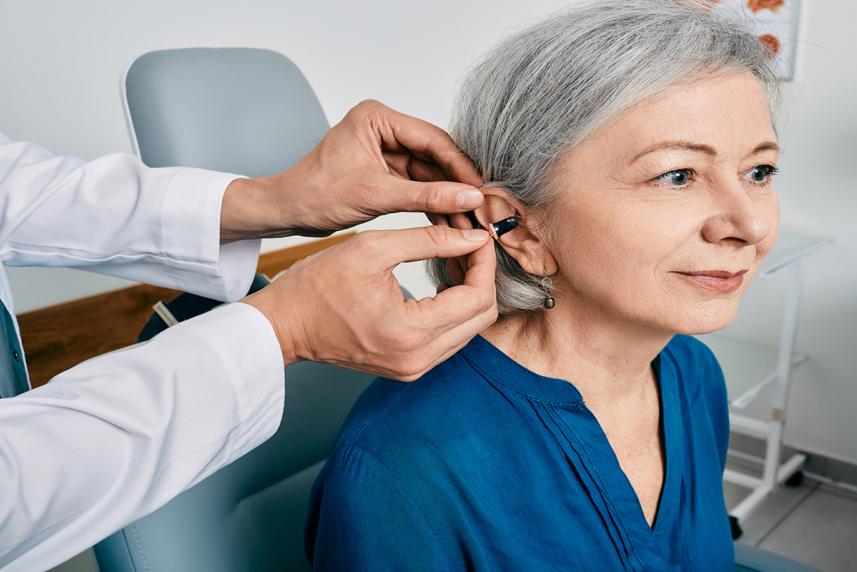
Aetna® care teams can help you find a doctor, schedule appointments, manage a condition, access the right benefits and more. It’s a personal benefit designed for Aetna Dual Eligible Special Needs Plan members.
Get answers to common questions about hearing aids — and learn ways to make them more affordable

If you’re having trouble hearing, but you feel on the fence about getting hearing aids, you’re not alone. Nearly one-third of older adults suffer from hearing loss.* And many of those wait a long time to get hearing aids — an average of nearly nine years after experiencing difficulty hearing.*
“Don’t put off getting hearing aids,” says Kimberly Rorabaugh Abeyta, AuD. She’s an audiologist certified by the American Board of Audiology. She’s also director of audiology at Virginia’s Hearing Resource Center and Ear, Nose and Throat and Facial Plastic Surgery Center, in Fredericksburg. Untreated hearing loss isn’t just an inconvenience. It’s also linked with serious health and well-being concerns, including:*

Aetna® care teams can help you find a doctor, schedule appointments, manage a condition, access the right benefits and more. It’s a personal benefit designed for Aetna Dual Eligible Special Needs Plan members.
Many people may be reluctant to get hearing aids because they think they’re clunky, ugly or uncomfortable. But nowadays you have plenty of options that are discreet and easy to wear.
“Most people know someone who has had a bad experience with hearing aids. But just because your uncle or grandparents didn’t do well with hearing aids doesn’t mean you will not do well,” says Abeyta.
Cost also holds back a lot of people. “But for most people, they are worth the expense. They can provide a huge improvement in quality of life,” says Abeyta. “And there are a lot of different options available to make hearing aids more affordable now, like leasing hearing aids.”
Many audiologists offer financing plans. (An audiologist specializes in diagnosing and treating hearing loss and balance problems.) It’s also possible to get hearing aids through organizations such as Lions Clubs International and the U.S. Department of Veterans Affairs. Also, some health plans give members an allowance for hearing aids.
Thinking about investing in hearing aids but have questions or concerns? Here are answers to common questions to help you make the right decision.
All hearing aids contain a microphone, an amplifier, a speaker (called a receiver) and a battery, says Rebecca Blaha, AuD. She’s the lead audiologist at the Pennsylvania Ear Institute of Salus University in Elkins Park, Pennsylvania. How those parts are put together depends on the type of hearing aid. Some have all the technology in one piece. With others, there might be one part that sits in your ear connected to another part that rests behind your ear.
Hearing aids can help you hear better by amplifying the sounds around you. But they don’t bring hearing back to normal, Blaha says. Instead, you need to relearn how to listen.
“When you first start hearing aids, your brain is going to focus on all of the little annoying sounds that you’re not used to hearing. But the more you wear them, your brain will get used to those sounds and learn what’s important to listen to and what it can ignore,” Abeyta says.
The tricky thing about hearing loss is that you might not even realize that you’re missing things. “People with hearing loss are often the last to know,” says Blaha. “When you lose sensitivity to sounds, you may not be aware of what you didn’t hear until someone alerts you that you missed part of the conversation.”
If friends or family have concerns about your hearing, it’s probably time to have your hearing tested to see if you could benefit from hearing aids. Another sign: You feel that you can’t take part in conversations the way you used to. Blaha stresses that hearing loss doesn’t have to be severe to benefit from a hearing aid.
“Some patients feel that their hearing isn’t bad enough to use a hearing aid,” says Blaha. “But these patients could be missing out on a really helpful tool.”
There are two main types of hearing aids: in the ear (ITE) and behind the ear (BTE). In-the-ear hearing aids, as the name suggests, nestle inside your ear. They’re typically the smallest and most discreet. But they aren’t always powerful enough for all types of hearing loss.
There are a few styles of ITE hearing aids:
Want more info about Aetna® plans and hearing benefits? Sign up> for email updates to stay informed — it’s free to learn more!
Like ITEs, behind-the-ear hearing aids also have one part that goes into your ear canal. But most of the hardware is in another piece that sits behind your ear. The two parts are connected by a wire that goes over the top of your ear. BTEs tend to be more powerful and offer more features.
Styles of BTE hearing aids include:
You can upgrade or reprogram BTE hearing aids if you need more power later on. They have longer-lasting batteries, which are often rechargeable, and other features such as Bluetooth. Because there’s a wire that goes over the top of the ear, they can sometimes get in the way when removing glasses, masks or oxygen tubes, or change the way glasses rest on your face.
The first step is to have your hearing checked by an audiologist. They will determine your level of hearing loss — mild, moderate, severe or profound. This will play a role in which type of hearing aid you need.
“Many people’s first thought is about the visibility of the device,” says Blaha. But there are several other factors to think about, she says. On the list:
Also, know that you might need to try more than one hearing aid before you find the right fit. “Not every brain works with every hearing aid. Even the most experienced clinicians will not get it right every time on the first try,” says Abeyta. “Make sure you really love the hearing aids before settling so you’re not stuck with a set of hearing aids that get thrown in a drawer.” Many have a 30-day trial period — take advantage of it.
If you qualify for both Medicare and Medicaid, you may be eligible for an Aetna® Dual Eligible Special Needs Plan (D-SNP).
If you're 65 or older and have an eligible chronic condition, you may qualify for an Aetna® Chronic Condition Special Needs Plan (C-SNP). CSNPs are currently available in select counties within IL and PA.
You may be eligible for an Institutional Special Needs Plan if you’ve lived (or plan to live) in a participating facility for 90+ days and you have Medicare Part A (hospital insurance) and Part B (medical insurance).
*FOR THE NUMBER OF PEOPLE SUFFERING FROM HEARING LOSS: National Institute on Aging. Quick statistics about hearing, balance & dizziness. Hearing Loss: A Common Problem for Older Adults. January 19, 2023. Accessed October 10, 2023.
*FOR THE AVERAGE LENGTH OF TIME BEFORE GETTING A HEARING AID: Simpson AN, Matthews LJ, Cassarly C et al. Time from hearing-aid candidacy to hearing-aid adoption: a longitudinal cohort study. Ear and Hearing. May-June, 2019; 40(3): 468-476. Accessed October 10, 2023.
*FOR HEALTH CONCERNS RELATED TO HEARING LOSS: Reed NS, Altan A and Deal JA. Trends in health care costs and utilization associated with untreated hearing loss over 10 years. JAMA Otolaryngology Head & Neck Surgery. January 2019; 145(1): 27-34. Accessed October 10, 2023.
The benefits mentioned are part of special supplemental program for the chronically ill. Eligibility is determined by whether you have a chronic condition associated with this benefit. Standards may vary for each benefit. Conditions include Hypertension, Hyperlipidemia, Diabetes, Cardiovascular Disorders, Cancer. Other eligible conditions may apply. Contact us to confirm your eligibility for these benefits.
Eligibility for the Model Benefit or Reward and Incentive (RI) Programs under the Value-Based Insurance Design (VBID) Model is not assured and will be determined by Aetna after enrollment, based on relevant criteria (e.g., clinical diagnoses, eligibility criteria, participation in a disease state management program).
See Evidence of Coverage for a complete description of plan benefits, exclusions, limitations and conditions of coverage. Plan features and availability may vary by service area. This material is for informational purposes only and is not medical advice. Health information programs provide general health information and are not a substitute for diagnosis or treatment by a physician or other health care professional. Contact a health care professional with any questions or concerns about specific health care needs. Providers are independent contractors and are not agents of Aetna. Provider participation may change without notice. Aetna is not a provider of health care services and, therefore, cannot guarantee any results or outcomes. The availability of any particular provider cannot be guaranteed and is subject to change. Information is believed to be accurate as of the production date; however, it is subject to change. For more information about Aetna plans, refer to our website. If your plan’s Extra Benefits Card includes roll-over, any unused amount will rollover into the next month. The monthly amount can be rolled over through the end of the plan year but will not carry over into the next plan year.
Nondiscrimination Notice | CA-Specific Nondiscrimination Notice
©2025 Aetna Inc.
Y0001_3721068_2025_M
3891507-14-01
Call us at 1-844-514-8290 (TTY: 711) between 8 AM and 8 PM, Monday to Friday. Or visit AetnaMedicare.com/YourDSNP anytime.